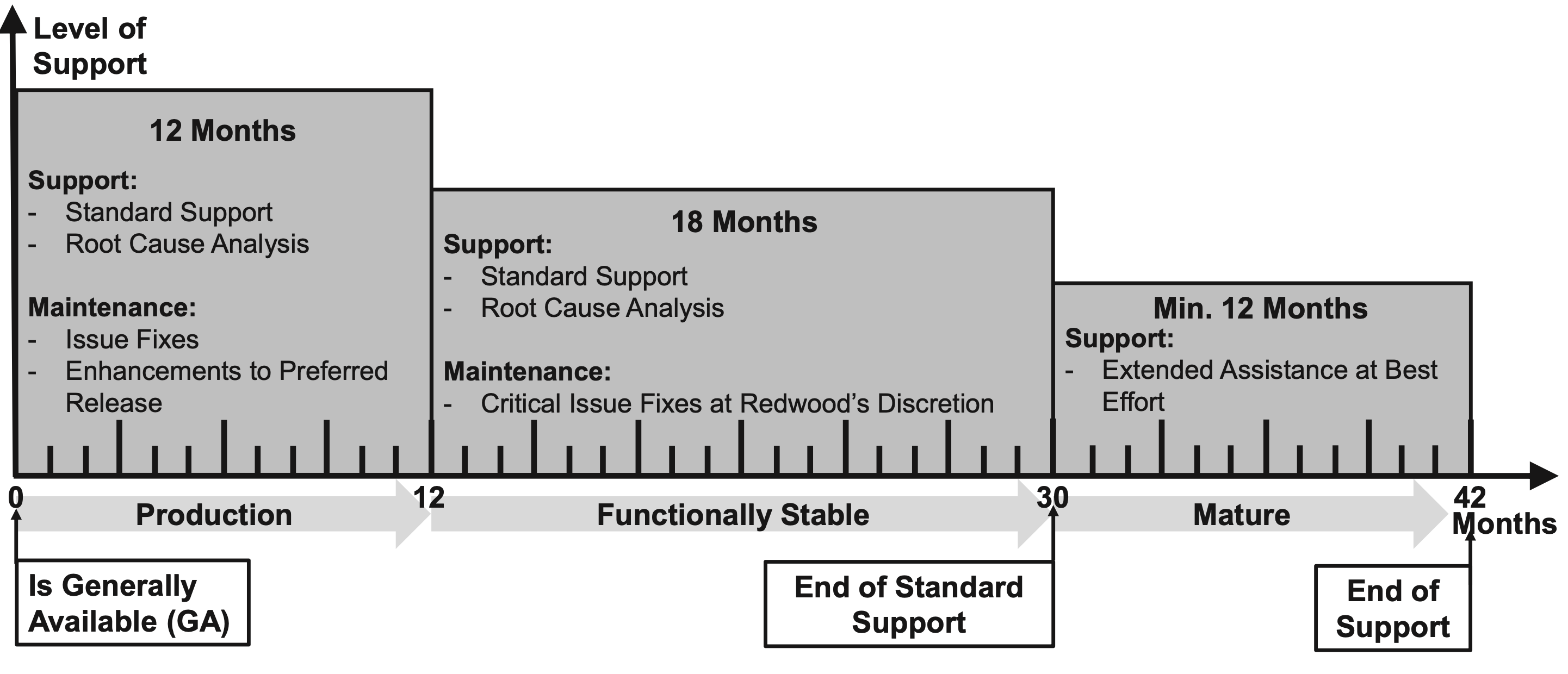 Product Release and Support Strategy for On-Site
Product Release and Support Strategy for On-Site
The Release strategy for on-site solutions ensures continued support.
Redwood development works in agile continuous delivery mode.
In order to synchronize the releases and provide comprehensive versions to customers, Redwood decided to shift to a calendar-based versioning for all its products. The new version scheme is derived from the date of release using the YYYY.release format, with one service pack that includes enhancements and bug fixes every quarter of the year.
Version Numbering
A version numbering is as follows <year>.<service_pack>.<patch_level>.<hotfix>.
| /Service Pack/Update | Patch Level/Patch | Hotfixes | |
|---|---|---|---|
| Description | A new service pack may include both product enhancements and fixes. Redwood provides service packs for active major versions on a quarterly basis. | A patch includes only corrections to reported issues. Patches are made available for all service packs in the production phase as required. They don’t follow a regular schedule. more details | Hotfixes are incremental and not always publicly released. |
| Example Version change | 2023.2 to 2023.3 | 2023.3.0 to 2023.3.1 | 2023.3.0.1 |
Active Version and Service Packs
Our development team provides enhancements and fixes to both the major and minor versions.
For active versions Redwood provides service packs (SP) every 3 months.
With an SP, only the second digit of the version changes (e.g. from 2023.1 to 2023.2). Redwood provides standard support for every SP for 30 months. After that, Redwood provides support at best effort.
Redwood adds enhancements only to the most recent SP, which is the preferred release.
SPs and patches are cumulative, so that the newest SP or patch includes all changes of the previous SPs and patches.
Redwood recommends updating to the latest SP at least once a year.

Lifecycle Phases and Level of Support for EACH Product Version / Service Pack

End-of-maintenance (EOM)
The end-of-maintenance date is defined as the point at which the software will no longer receive updates or bug fixes, but support will still be available to users. End-of-life happens 12 months after the release date, and notifications will be sent to users before that date.
Updates or patches for software applications that have reached their end-of-maintenance date will no longer be provided.
End-of-life (EOL) or End-of-support (EOS)
The end-of-support date is defined as the point at which the software will no longer be supported, and no further updates or bug fixes will be provided. End-of-support happens 18 months after the end-of-maintenance date as described in the documentation at the time of the release.
How to Install New Product Versions
You download all product versions directly from the support portal. In every product version, Redwood ships software as a whole to ensure that you can install new product versions with minimal risk and effort. Newer patch levels and/or service packs include all previous changes. This means that it only takes one update to get the latest SP version. The process of installing a new version is designed to be simple and have no impact on the objects stored in the underlying database.
When you install a new version, the installation process itself manages all product components and connected agents on remote systems. This ensures compatibility and rapid deployment, further reducing risk and required effort.
Updates vs. Upgrades
Updates and upgrades use the same technical method, however, upgrading less often has a bigger impact than frequent updates. A product update is usually fully automated. An upgrade from older versions may involve additional manual activities.
Redwood teams will suggest moving to a new major release when either:
- The product version used has reached end-of-life and is no longer supported.
- The release used by you no longer receives non-critical patches because it is deemed mature.
- Key requirements can only be met with the new major release.
See Also
onsiteTopic
